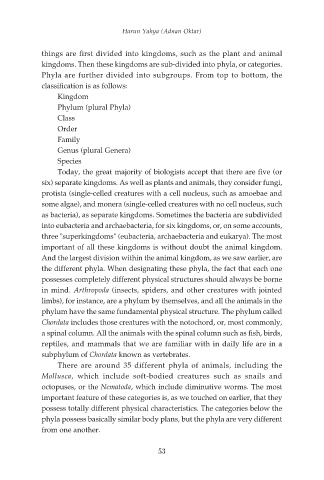Page 55 - Darwinism Refuted
P. 55
Harun Yahya (Adnan Oktar)
things are first divided into kingdoms, such as the plant and animal
kingdoms. Then these kingdoms are sub-divided into phyla, or categories.
Phyla are further divided into subgroups. From top to bottom, the
classification is as follows:
Kingdom
Phylum (plural Phyla)
Class
Order
Family
Genus (plural Genera)
Species
Today, the great majority of biologists accept that there are five (or
six) separate kingdoms. As well as plants and animals, they consider fungi,
protista (single-celled creatures with a cell nucleus, such as amoebae and
some algae), and monera (single-celled creatures with no cell nucleus, such
as bacteria), as separate kingdoms. Sometimes the bacteria are subdivided
into eubacteria and archaebacteria, for six kingdoms, or, on some accounts,
three "superkingdoms" (eubacteria, archaebacteria and eukarya). The most
important of all these kingdoms is without doubt the animal kingdom.
And the largest division within the animal kingdom, as we saw earlier, are
the different phyla. When designating these phyla, the fact that each one
possesses completely different physical structures should always be borne
in mind. Arthropoda (insects, spiders, and other creatures with jointed
limbs), for instance, are a phylum by themselves, and all the animals in the
phylum have the same fundamental physical structure. The phylum called
Chordata includes those creatures with the notochord, or, most commonly,
a spinal column. All the animals with the spinal column such as fish, birds,
reptiles, and mammals that we are familiar with in daily life are in a
subphylum of Chordata known as vertebrates.
There are around 35 different phyla of animals, including the
Mollusca, which include soft-bodied creatures such as snails and
octopuses, or the Nematoda, which include diminutive worms. The most
important feature of these categories is, as we touched on earlier, that they
possess totally different physical characteristics. The categories below the
phyla possess basically similar body plans, but the phyla are very different
from one another.
53

